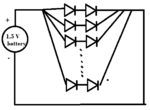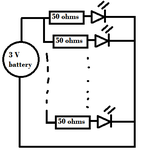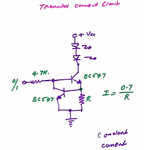Jay_
Member level 3

Hi, I just had a simple question. If I have a 1.5 volt battery source and 1 V rated LEDs, is it okay for me to have a ladder of 20 rungs, with each rung having 2 LEDs in series WITHOUT a current limiting resistor?
I also know that it would be better for me to have a constant current source, or a PWM at high frequency to use the LEDs to maximum efficiency. But do I need a current limiting resistor? Because if I do place one, I will be wasting a lot of energy through the resistor and I also figured that the voltage across both the LEDs in any rung is 1.5 V which is less than 1 + 1 = 2V. Also if I connect only one LED in a rung with a series resistor (to dissipate the 0.5 V), I will be wasting a lot of my battery energy through the resistor.
I also know that it would be better for me to have a constant current source, or a PWM at high frequency to use the LEDs to maximum efficiency. But do I need a current limiting resistor? Because if I do place one, I will be wasting a lot of energy through the resistor and I also figured that the voltage across both the LEDs in any rung is 1.5 V which is less than 1 + 1 = 2V. Also if I connect only one LED in a rung with a series resistor (to dissipate the 0.5 V), I will be wasting a lot of my battery energy through the resistor.






